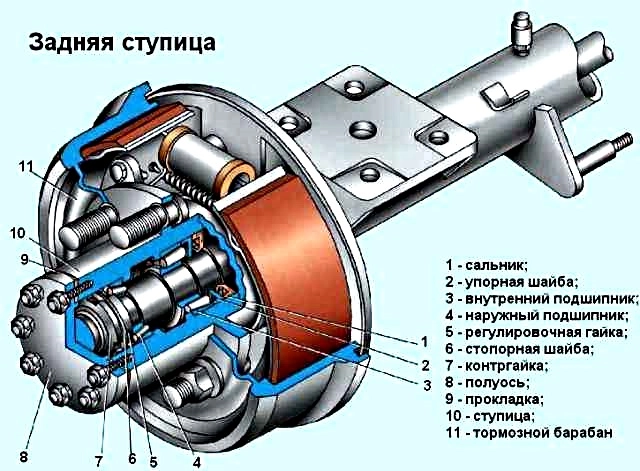The vehicle is equipped with a rigid rear axle in the form of a beam consisting of the main gear housing and the axle shaft housings pressed into it.
The main gear with the differential form a gearbox, which is installed in the housing opening and secured with bolts.

1 - brake drum; 2 - hub; 3 - hub seal; 4 - thrust washer; 5 - axle shaft housing; 6 - hub bearings; 7 - bearing nut; 8 - lock nut; 9 - axle shaft flange; 10 - stud; 11 - gasket; 12 - right differential pinion box; 13 - rear axle housing; 14 - pinion support washer; 15,19 - axle shaft gears; 16 - pinion support washer; 17 - pinions; 18 - pinion shaft; 20 - left differential pinion box; 21 - beam; 22 - axle shaft; 23 - differential bearing nut; 24 - differential bearing; 25 - final drive driven gear; 26 - breather; 27 - nut; 28 - washer; 29 - pinion flange; 30 - cuff; 31 - mud deflector; 32,34 - pinion bearings; 33 - spacer ring; 35 - adjusting ring; 36 - pinion; 37 - gearbox housing; 38 - bolt; 39 - lock plate
Gear-type differential. The differential box consists of two parts that are bolted together.
The driven gear is bolted to it. The differential box contains two axle gears and four satellites that are in constant engagement.
Thrust washers are installed between the differential box and the ends of the axle gears and satellites.
The satellites rotate around axles that are fixed to each other in the differential box using recesses in the central part.
Tapered roller bearings are pressed onto the differential box journals.
The beam housing contains mounting seats for the differential bearings and adjusting nuts for the differential bearings.
The differential assembly with the driven gear and bearings is attached to the gearbox housing with two bolted covers.
At the manufacturer's plant, the housing seats and bearing covers are machined as an assembly, so the covers are not interchangeable.
The adjusting nuts provide the necessary lateral clearance between the main gear pinions and the preload of the differential box bearings.
The adjusting nuts are secured from movement by locking plates, which are attached to the bearing caps with bolts.
The main gear is hypoid, the axis of the driving gear is shifted downwards relative to the axis of the driven gear by 42 mm.
The gear ratio of the main gear is 5.125

The outer part of the axle shaft, made in the form of a flange, is attached to the rear wheel hub with nuts or bolts
Studs for fastening wheels and brake drums are pressed into the hub.
Adjust and fix the bearings in the axial direction with an adjusting nut and a lock nut.
An oil seal is pressed into the hub behind the inner bearing.
The splined part of the axle shaft is installed in the axle gear.
Possible malfunctions of the rear axle
- Cause of malfunction - Method of elimination
- 1. Loud bridge noise (hum):
- - Drive pinion flange nut loose - Tighten the nut
- - Wear or play in the working surfaces of the drive pinion or differential bearings - Check the working surfaces of the bearings and replace them if necessary. Adjust the bearing tension
- 2. Pulsating bridge noise (loosening):
- - Drive pinion mounting bolts loose or installed at an angle - Tighten the drive pinion mounting bolts and check the runout of its "back"
- 3. High-pitched "howling" bridge noise:
- - Insufficient or excessive oil level - Restore oil level to normal
- - Non-recommended oil is used - Change oil
- - Incorrectly adjusted contact between the teeth of the new final drive gears - Check the contact patch and adjust it
- - Scoring on the working surface of the final drive teeth - Replace gears
- 4. A loud knock in the axle when pressing the accelerator pedal sharply after coasting or turning:
- - Excessive wear of differential parts - Check the total play in the main gear and differential. Replace worn parts
- 5. Continuous knocking and crunching in the axle:
- - Wear of teeth or bearings - Replace worn parts
- 6. Oil leak through the cuffs of the drive pinion, hub, and also along the plane of the joint between the crankcase and cover:
- - Wear of the cuffs of the drive pinion and rear wheel hubs, drive pinion flange, crankcase journal - Replace worn parts
- - Clogged breather - Clean the breather
- - Loose tightening of the crankcase cover mounting bolts - Tighten the bolts
- - Deformation of the crankcase cover - Replace the cover
- - Damage to the cover gasket - Replace the gasket





